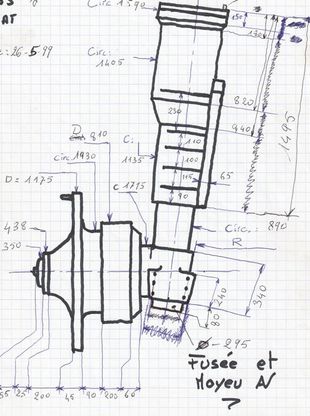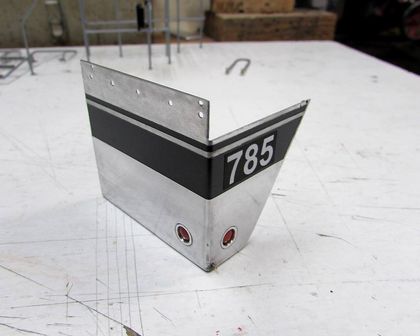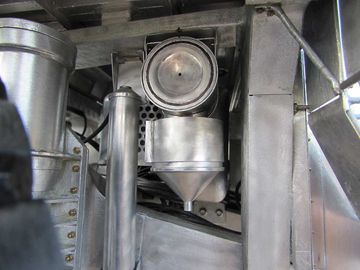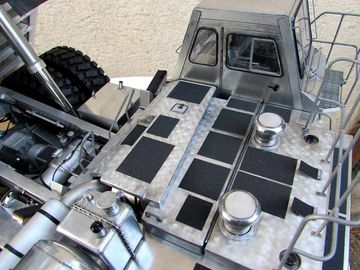"The aluminum collection".
THE CATERPILLAR 785 TRUCK,
scale: 1/15 th.
LThe plans are the result of the usual process: the measurement of dimensional dimensions on the real machine.
Note that here we are in front of the largest machine studied, therefore the largest model
to reproduce from the Caterpillar collection.
Personal impression at the time of the odds reading:
"Facing a" monster "more than 6 meters in width, more than 5 meters in height,
11 meter long and fitted with 3 meter diameter tires.
Make a statement of dimensional dimensions over a period of 7 days,
execute the most precise plans possible, undoubtedly remains the hardest job
and which most often generates a mixture of tension and stress ...! "
LThe construction of this model is also made of aluminum glued with epoxy glue
for high stresses (reinforced by pegging) and cyanoacrylate glue
for low stresses ".
Production: from February 1998 to May 2003,
totaling: 2750
hours.
The real machine ...
Extract from dimensional measurements at the surface mine
de Mercoirol (la Grand-Combe, Gard) 1998/1999.
The model.
The chassis.
All the parts constituting the frame are traced, cut and folded by hand because it is necessary to respect very precise profiles and dimensions. All cut from 0.5 mm aluminum sheet. The multiple fixings are obtained by gluing (epoxy glue), after having been reinforced by internal screws, installed before the application of the glue, in order to obtain more resistant seals for the different assemblies of the parts.
The body.
It is also made of aluminum sheet 0.5 mm thick and shaped by hand.
It mainly consists of ten removable elements (including the cab), using M1 and M1.6 studs.
The transmission.
SOn the model, the mechanical components which constitute the transmission are present and may be functional. But the option chosen for this model is to stay in a "static" register; it is a choice in relation to the finish aspect of this model.Indeed, we can easily imagine that it can deteriorate very quickly,
at least on this type of construction and finish,knowing all theconstraints
what canundergopublic works machine, especially small.
The kinematics.
She is made of :
- a 12-volt automobile heating fan electric motor drives the rear axle via a telescopic shaft between two cardan joints.
- a gearbox in the ratio: 1/1 and an epicyclic gear at the entrance of the rear axle to the ratio: 3.5 / 1. Some components, such as the universal joints and the toothed crown are made "in house", (molding).
- the rear axle includes a bevel gear in the ratio: 3/1 with differential.
- the kinematic chain ends with a double reduction with an epicyclic train in each hub, with a ratio of: 3.5 / 1 per train.
Functional organs.
Steering cylinders and bucket.
They are of personal design.
As for the D8K, the option chosen for their operation is pneumatic energy,
this choice is related to the finishing aspect of the model.
The suspension cylinders.
The tires.
They are molded "house" as follows:
1) plaster cast of a drilled drum, all at dimensions slightly higher than the final tire.
2) machining of the different shapes (internal curve, external chamfer).
3) drawing of the different sculptures on its radial surface.
4) carving, one after another and by hand of these sculptures.
5) finishing: soft sanding and painting to benefit from a non-porous surface Once the model is finished, we move on to the construction of the mold.
6) making a circular formwork with a diameter greater than the plaster model.
7) positioning of the plaster model inside the formwork, slightly raised and resting on three studs.
8) immersion up to its radial axis, in a liquid elastomer.
9) after polymerization, total immersion of the plaster model in the same elastomer. Pre-lubrication is desirable to prevent the two materials from bonding together.
10) demoulding at all. Two hollow flexible elastomer half-shells are then obtained and the plaster model is recovered which is intact.
11) hand pouring of a product of your choice in each of the flexible half shells.
12) demoulding of the half-tires which are then glued radially together and machined to remove excess glue. A hollow tire is thus obtained with, in its center, a starting point on both sides.
Lguardrails, access ladders ...
They are all fixed using M1 studs and therefore,
they are all removable like on the real machine.
The dumpster.
All aluminum profiles (side members, cross members, boxes),are hand trained
on wooden templates specially designed for this purpose.
All the elements are then glued with epoxy glue.
Model completed.
Dimensions:
Overall length: 735 mmOverall width: 420 mmOverall height: 376 mmWeight: 15 kg
Some details...
Finally, commercial pieces:
- aluminum sheets 0.5 mm thick.
- the micro screws of M1 and M1,6.
- all rods of different diameter.
- small diameter tubes.
- the pinion (except the crowns).
- the different glues: epoxy, cyanoacrylate, neoprene.













































































